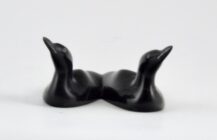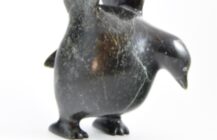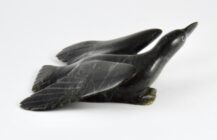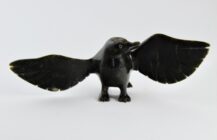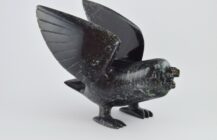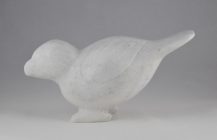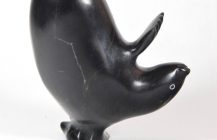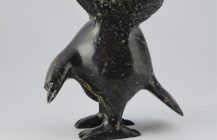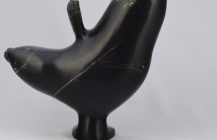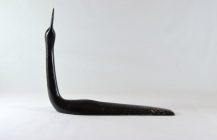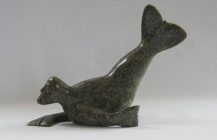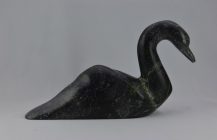Ning Ashoona
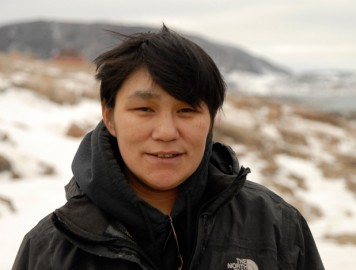
(1979 -) | Cape Dorset, Nunavut, Canada
Ning Ashoona By The Sea
Ningeosiak Ashoona was born on December 20, 1979 in Frobisher Bay (Iqaluit). She soon arrived in the family community of Kinngait (Cape Dorset) and began living with her grandparents on the land.
One Inuit tradition is for the grandparents to adopt the first child of their children, like with Ningeosiak, the first child of Miali (Ashoona) and Teetee Curley she was adopted by Miali’s parents, Mayoreak and Qaqaq Ashoona. The child is raised in this extended family, living and raised by her grandparents and still connected to her natural parents. Teetee is a carver of mainly polar bears. Miali (Mary) was an artist who made beadwork. Mary passed away last year at the age of 53.
Ning was born into a family of talented artists. Her great grandmother, (Mayoreak Ashoona’s mother) Sheouak Parr was one of the first Inuit women to participate in the early drawing projects of the 1950s. Pitseolak Ashoona, RCA, her great grandmother (Qaqaq Ashoona’s mother) was a legendary artist for her drawing, prints and paintings. She was one of the first artists to make drawings for the print studio in Cape Dorset in the early 1960s. She was a member of the Royal Canadian Academy of the Arts and received the Order of Canada in 1977. Her great uncle is Kiugak Ashoona, RCA, who was a famous master carver who was also appointed to the Order of Canada in 2000.
Ning lived her younger years with her grandparents in Saturituk, (Mayoreak’s birthplace) on the southern coast of Baffin Island. Living in this isolated outpost camp instilled in Ning a deep attachment to the land. All Qaqaq and Mayoreak’s children learned how to make art, either graphic art or sculptures from their parents. Ning’s three uncles – Oqitu (Ohito) Ashoona, Ottokie Ashoona and Sapa Ashoona and her aunt Siassie (Ashoona) Keanelly were like siblings to Ning growing up. Mayoreak and Qaqaq’s children are all well known artists.
Life on the land was based on the seasons. During summer the family would travel and camp at different locations along the coast hunting and fishing. Weeks were spent camping and mining stone at the soapstone quarry sites east of Cape Dorset and transporting it back by boat to the camp. Winter was living based in the outpost camp with day or overnight trips for hunting. Ning fondly remembers going fishing in the shallow waters of the lake in the fall when the fish are swimming up the river from the ocean to the lake. She would be standing on the rocks in the shallow waters, moving the rocks until the fish emerge. Ning would use a stick with a noose to catch the fish.
Carving and making drawings were the main livelihood of camp life. These artworks were taken to Cape Dorset West to sell at the Co-op where they could then purchase supplies to be able to sustain living at the outpost camp. They lived at Saturituk camp until her grandfather’s Qaqaq’s death on Sept 27,1996 after which they moved to Cape Dorset.
Both of Ning’s grandparents were recognized master carvers whose art celebrated traditional Inuit culture. Her grandfather Qaqaq used only hand tools and took great care with the details. Mayoreak is a strong figure in Ning’s life and set the example of women making art by carving. Ning learned many skills by watching her grandmother carve. She would help Mayoreak carve mermaids and loons. Ning watched her grandmother go through a major transformation with her art after her grandfather died. Inspired by Mayoreak’s determination and imagination along with her family’s traditional skills, she too became a woman carver.
Ning shared this story with us –
“At the stone quarry, when I was young girl I saw something through the fog; I thought I saw a mermaid in our boat, and when I went to tell my grandfather, the mermaid was already off the boat. I try to imagine what it would be like to be a mermaid, but my grandmother did not talk about these subjects with me, though she carved these often.”
Ning’s favourite subject to carve is the loon. When she was younger sometimes the nets set at the lake would accidentally catch young loons. She was between 7 and 10 years of age and she would look after them for a few days before they died. She observed their beauty and cared for them.
Being Inuk is important to Ning. She has thought about the women, Umallu Oshutsiaq, Mary Oshutsiaq, and Ovilu Tunillie who carved with her. When they passed away, she thought “Am I the only woman carving right now?” Her grandmother due to her age has stopped carving. She thought about shying away from it but she doesn’t, she continues to carve, she says “I just may as well do the carving”. Ningeoseak is the only full time female artist carving in Cape Dorset.
Ning did not attend western school because she lived on the land with her grandparents. She developed her carving skills and is able to support herself and her four children through her artwork. If she had attended school her life would be different. She learned from her grandparents what she needed to survive. She has shared her skills with others in the community and mentored her natural brother, Kumuatuk Curley, age 23, Miaili & Teetee’s son. Kumuatuk is currently a carver living in Toronto.
Ning’s favourite carvers are Pootoogook Jaw because of the energy of his carvings and Ashevak Tunillie for his walking polar bears.
Ning’s early life was a traditional one centered around hunting, trapping, fishing, and carving. She has now been a full time carver for over 20 years with a family of her own to support. She uses both hand and power tools. The power tools help to increase her productivity and she uses the hand tools for intricate delicate work. She is inspired by the beauty of Arctic animals and uses her creativity to envision new forms for her favourite subjects. Her slender and delicate loons exhibit the fragility of life. The fluid Mermaids and Sedna’s with their elegant fins are elusive in the Arctic waters. The balance of the Sea Spirits and Diving Seals is amazing. Ning’s playful seals are often carved swimming or enjoying life. The negative space around her carvings add to the sculptures presence. Ning Ashoona has a uniquely feminine perspective.

